Anki is an amazing tool, but like any tool, it can be used incorrectly. If you use Anki incorrectly, you will waste time and not retain the information (two very bad outcomes).
These tips are more advanced than my previous guides but help you maximize your efficiency with Anki.
1. Get Organized
Everything you are actively studying should be under one deck. This is what my deck looks like after my studying for the day.
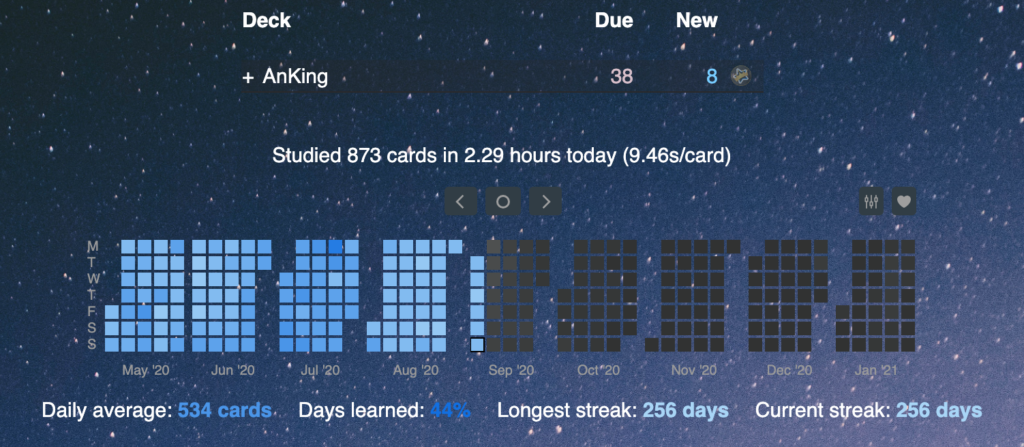
This means when I start studying I just click one thing. I am not hunting for cards or subdecks. I am clicking one thing.
Mixed learning is better learning. In whatever exam you are taking, and Step, will the exam be in the order of topics? No! Everything will be mixed together randomly. If the Hebbian Theory is correct, mixed learning is better learning. That’s why I study everything together randomly.
Also, when you are reviewing a certain topic, say respiratory, you are being given a hint to what the answer will most likely be.
To make sure you are practicing mixed learning have everything under one deck and select “show new cards in random order.”
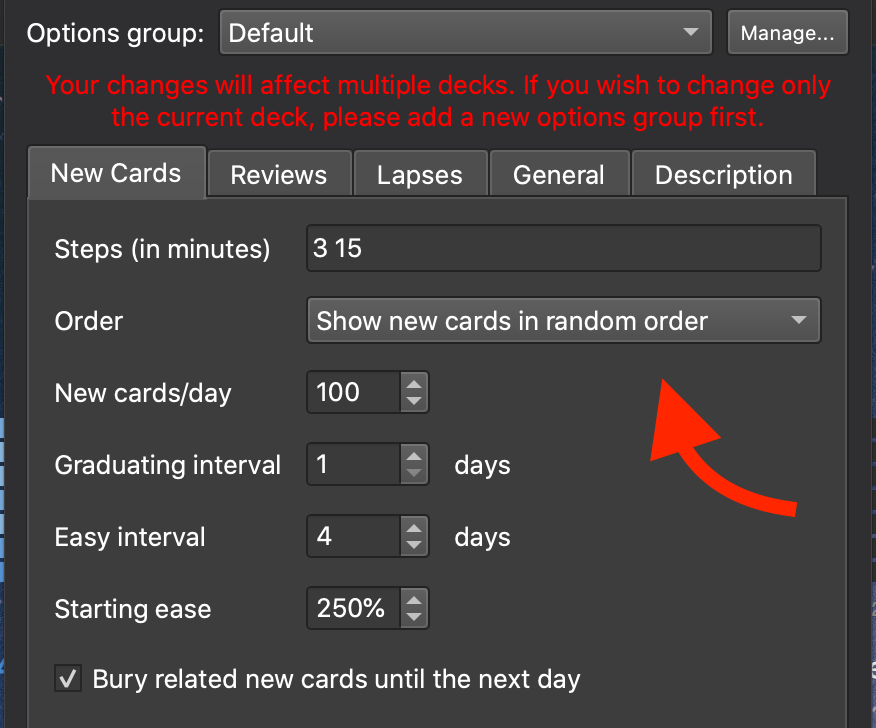
The other thing you need to do is make sure you have Anki scheduler 2.1 selected by going to preferences -> scheduling -> Check Anki 2.1 scheduler (beta).
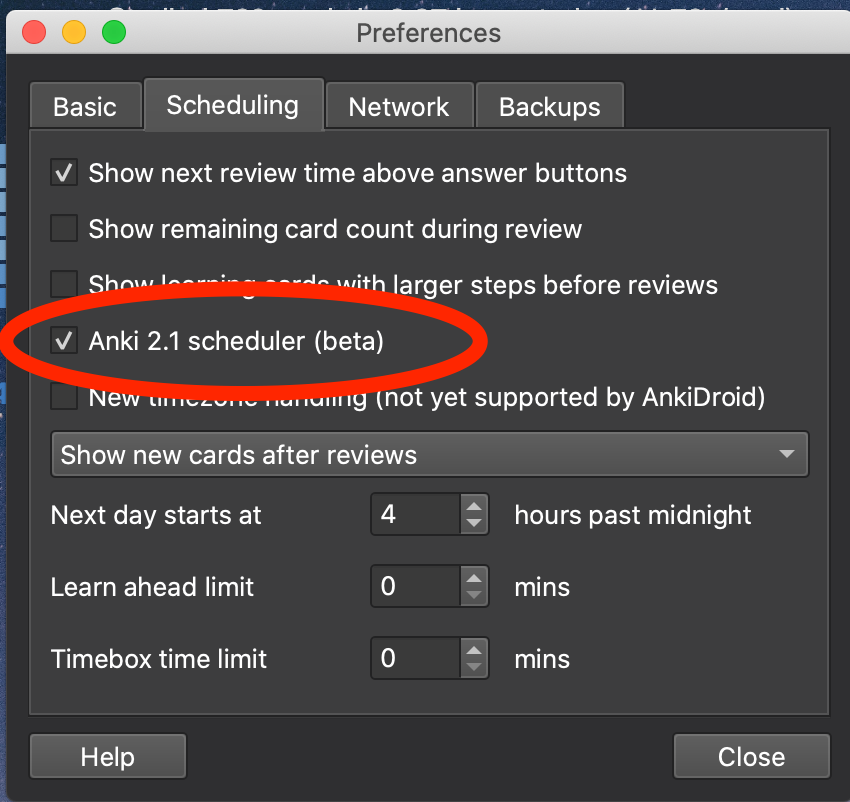
You can see the full changes with the new scheduler here.
2. Use the Pomodoro Method
The Pomodoro method splits up your learning into intervals. You study for a certain amount of time then take a break for a certain amount of time. I’m partial to the traditional 25-minute study and 5-minute break interval. This interval helps me not go insane while studying and improves your productivity. Scientific articles in support of this here and here.
Except, on the fourth break, you take a 20-30 minute break. A study day would look like this:
- 25 Min Study
- 5 Min Break
- 25 Min Study
- 5 Min Break
- 25 Min Study
- 5 Min Break
- 25 Min Study
- 30 Minute Break
- Repeat as many times as you can handle it…
3. Finding New Cards
As you accumulate cards, and decks, it is very easy to get lost in the multiple subdecks. You should be learning new cards via tags and the unsuspend tool and not via individual decks.
Searching through individual decks will take too long as time goes on.
One bonus tip for those of you using the AnKing deck, when figuring out which cards to unsuspend, if you don’t want to use my method outlined here, go to browse and sort by “date created.” A large portion of the AnKing deck is the Zanki deck, this is a single person that created cards in a logical order. It isn’t a bad idea to unsuspend the cards in the order they were originally created.
4. Edit Premade Cards
The premade cards are amazing, however, there are certain connections and topics that only make sense in a certain way in your head. You are understanding and not memorizing right? So, every card, you understand and you may even draw connections to other topics.
For example, we are currently learning about the genitourinary system in females. There are certain female genital pathologies, I noticed, that seem to all present with leukoplakia (a pre-cancerous white lesion).
So I saw this card:

And added this in the “extra” section:

Now when I study this card I will see that Lichen sclerosis presents similarly to these other pathologies. Bam! It’s like a triple spaced-repetition combo-punch.
When I speak to top students and performers one thing they all have in common is they make connections. It makes sense right? If the way memories are made is neural connections, and more neural connections mean a stronger memory, should we try and make as many of these neural connections as possible?
5. Do the Cards Every Day
Spaced repetition works because you are studying the items right before you fall off the forgetting curve. I wrote a whole article on the “why,” here.
If you don’t study every day you fall off of this graph, you forget the information.
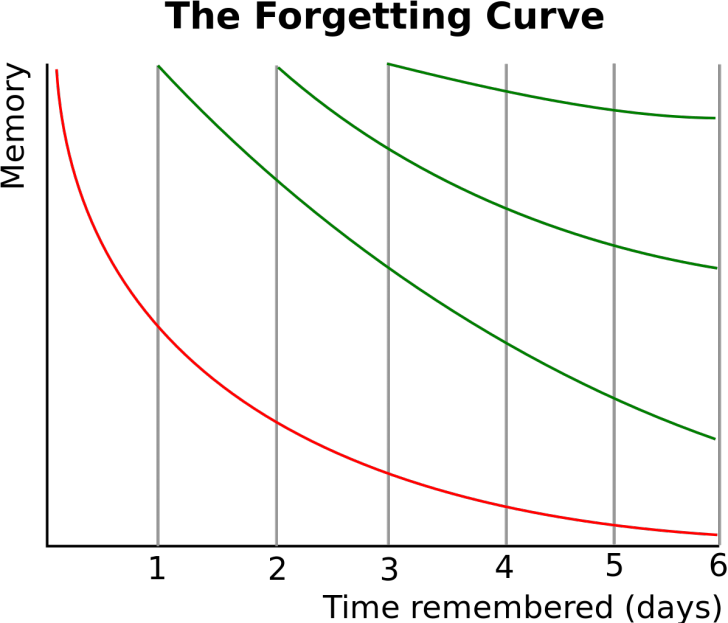
Study every day for long term retention. That’s how the algorithm is built and how Anki is meant to be used.
Many people say you should do your Anki cards on your commute or when you have downtime. I disagree. This is the most important thing I do in regard to retaining medical school information so it’s the first thing I do every day no matter what. If I only do it when I have free time I would never do all of my cards.
6. Aim for 80-90% Success Rate On Reviews
When you are reviewing your older mature cards, which are cards that have greater than 21 days until their next review, you should be marking “good” on 80-90% of them.
If you are over 90% the cards are showing up too frequently and you are wasting your time with them. If you are under 80% the cards are too difficult and the time between the cards is too long.
There is research to back this up that basically says that there is a sweet-spot in your brain, a Goldilocks zone for maximum retention. Your brain likes a challenge, but not too hard a challenge.
So how do you check and fix this? First, you need to check what you are at, so go to your main deck and hit “Stats”

When you click this you will see a bunch of statistics depending on your addons.
Scroll up until you see the information pictured below.

If you don’t see this information you need to download the addon True Retention. All this addon is doing is calculating your pass rate with “Review” cards, which is what we want instead of the default Anki stats which takes into account all cards including younger cards.
We want to know our retention over the long term right? As that is the whole reason we are using Anki in the first place.
As you can see I am right in that sweet spot, maybe my cards are a little too easy.
Ok so what if your number is too high (above 90%) or too low (below 80%)? You need to make modifications to your interval modifier.
Go into your deck and click on the cogwheel next to it.

Then go to reviews and adjust the interval modifier. All this is doing is changing the time between card reviews. I would:
- If your true retention rate is too high (above 90%)
- Your cards are too easy and showing up too close together. Increase the interval modifier by 10%, to 110%, and assess the true retention rate over the next couple of weeks. If it is still too high you may need to get more drastic with the changes and keep playing around until you hit ~85% true retention.
- If your retention rate is too low (below 80%)
- Your cards are too hard and showing up too far apart. Decrease your interval modifier so the cards are showing up closer together. I would decrease it to 90%, and then monitor the true retention rate for a couple of weeks.
Luckily the Anki algorithm has worked just fine for me! So I stick at around 100%, in the beginning though, when I had only a few cards, I had my interval modifier at around 200%.
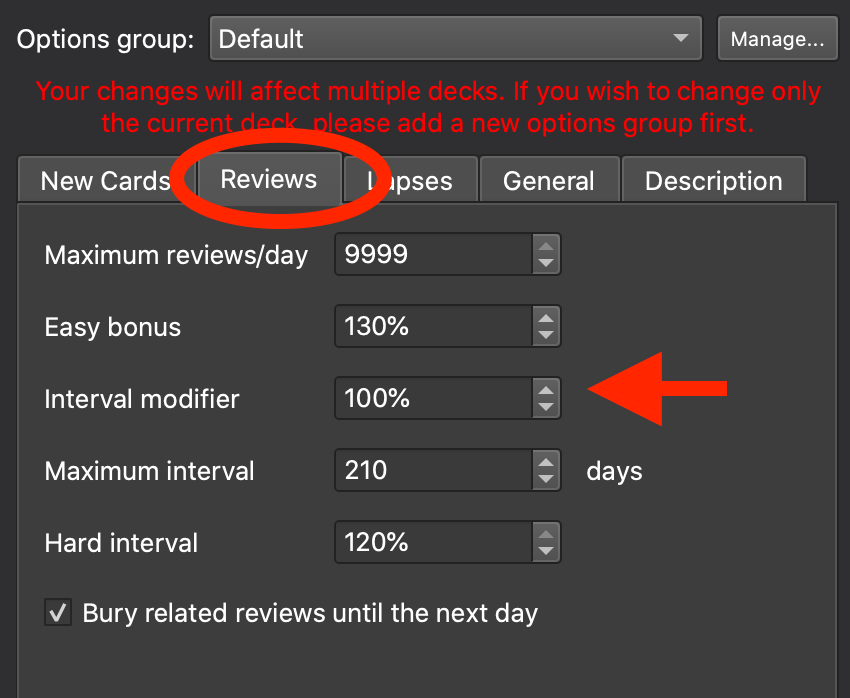
7. Learn Keyboard Shortcuts
Command + Shift + 4 → screenshot a desired area of your screen
While Reviewing Cards:
E → Edit Card
A → Add Card
Space → Show Answer / Answer Good
1 → Answer Again
2 → Answer Hard
3 → Answer Good
4 → Answer Easy
Shift + 2 → Suspend Card
Command + Z → Undo
In Browse
Command + A → Select All Cards
Command + J → Suspend Toggle
8. If You Are Creating Cards…
- Create fewer cards, there are endless resources out there that are amazingly created, edited, and analyzed by teams of people over multiple years. Which decks do you think will be better? Yours or theirs? I know there is the argument that when you create your own cards you are learning that material, but, in the end, it just takes too much time. I’m a second-year medical student now, nearly every one of my friends that made their own cards last year has stopped and are now using premade decks.
- Keep your cards short, only one fact per card is good a rule of thumb.
- Do not try and memorize every detail, you will quickly accumulate too many cards and not be able to keep up with the reviews. Instead, try to only focus on the high yield topics by seeing what pops up on practice questions and across multiple lectures.
- Use Cloze deletion cards. Research and ‘professional’ Anki users all recommend it.
- Link to external resources. You want to be able to get the full picture of the fact you are learning, you may understand it completely when you are creating the card, but when you see it in a couple of months you may not remember that information.
9. Make it Pretty!
This isn’t necessarily an advanced tip, but you will be likely looking at this Anki screen for many many hours. Make it nice to look at.
Download the customize background addon and watch this video I made on how to implement it.

6 comments
Ankit
i have notice that my True retention in anking deck is 84.5% but the percentage of mature card correct answer rate us only 75.81% , what should i do ? should i modify interval modifier or is it fine?
Zach
Mature card correct answer rate is all that matters, but it sounds like you are a little low, I would adjust the interval modifier a small amount to make the cards appear more frequently (maybe 5%).
Wojtek
hi Zach
I’ve got one question. What would you do if there isn’t any pre-made decks? I’m in this kind of situation, because there isn’t any decks that suits my country program. What would you recommended? Should I making cards by myself (that’s the way I’m going now), or maybe use some pre-made decks that contain content not similar enough to that what I have to learn and try to learn missing content from my books? I apriciate any answer.
Zach
Hey, many people run into this issue, your best bet is making your own cards. Just make sure you don’t make cards that are too detailed or make too many cards a day or it will take up all of your time.
I would search to see if maybe there are certain, reputable, decks that you can pick and choose from. For example, there aren’t many comprehensive decks on biology, but there is a great deck on memorizing the amino acids.
DAniel
How long do you suggest waiting before changing the interval modifier after seeing true retention settings? I am MS2 and been using AK for sketchy and pathoma mostly with TR of 92%. I have only been using it for 3 weeks, but if I can save myself some time that is always great. I just don’t want to jump the gun on changing settings. I appreciate any input!
Zach
I would change then evaluate after one month. Or one week with smaller changes.